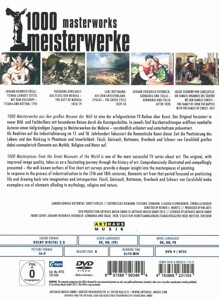
Zustellung: Fr, 22.08. - Di, 26.08.
Versand in 1-2 Wochen
Zzgl. Versandkosten*Als Reaktion auf die Industrialisierung im 17. und 18. Jahrhundert fokussiert die Romantische Kunst dieser Zeit die Poetisierung des Lebens und den Rückzug in Phantasie und Innerlichkeit. Füssli, Géricault, Rottmann, Overbeck und Schnorr von Carolsfeld greifen dabei exemplarisch Elemente aus Mythik, Religion und Natur auf. Johann Heinrich Füssli: Titania und Bottom (1790),Théodore Géricault: Das Floß der Medusa (1818/19), Carl Rottmann: Griechischer Zyklus (1836), Johann Friedrich Overbeck: Germania und Italia (1828), Julius Schnorr von Carolsfeld: Die Familie Johannes des Täufers bei der Familie Christi (1817)
"1000 Masterpieces from the Great Museums of the World" is one of the most successful TV series about art. The original, with improved image quality, takes us on a fascinating journey through the history of art. Comprehensively illustrated and compellingly
presented - the well-known authors of five short art surveys provide a deeper insight into the masterpieces of painting.
In response to the process of industrialisation in the 17th and 18th centuries, Romantic art from that period focussed on poeticising life and drawing back into imagination and introspection. Füssli, Géricault, Rottmann, Overbeck and Schnorr von Carolsfeld make exemplary use of elements alluding to mythology, religion and nature.
Johann Heinrich Füssli: Titania and Bottom (1793), Théodore Géricault: The Raft of Medusa (1818/19), Carl Rottmann: Zyklus - The Greek Cycle (1839-50), Johann Friedrich Overbeck: Germania and Italia (after 1828), Julius Schnorr von Carolsfeld: The Family of Johann the Baptist with the Family of Christ (1817)
presented - the well-known authors of five short art surveys provide a deeper insight into the masterpieces of painting.
In response to the process of industrialisation in the 17th and 18th centuries, Romantic art from that period focussed on poeticising life and drawing back into imagination and introspection. Füssli, Géricault, Rottmann, Overbeck and Schnorr von Carolsfeld make exemplary use of elements alluding to mythology, religion and nature.
Johann Heinrich Füssli: Titania and Bottom (1793), Théodore Géricault: The Raft of Medusa (1818/19), Carl Rottmann: Zyklus - The Greek Cycle (1839-50), Johann Friedrich Overbeck: Germania and Italia (after 1828), Julius Schnorr von Carolsfeld: The Family of Johann the Baptist with the Family of Christ (1817)
Produktdetails
Erscheinungsdatum
25. März 2013
Untertitel
FSK freigegeben ab 00 Jahren.
Laufzeit ca. 50 Minuten.
DVD-Video Album.
Laufzeit
50 Minuten
FSK-Freigabe
00
Autor/Autorin
Various
Komponiert von
Various
Produktart
DVD
Gewicht
79 g
Größe (L/B/H)
188/139/10 mm
GTIN
0807280503494
Entdecken Sie mehr
Bewertungen
0 Bewertungen
Es wurden noch keine Bewertungen abgegeben. Schreiben Sie die erste Bewertung zu "Europäische Romantik" und helfen Sie damit anderen bei der Kaufentscheidung.











